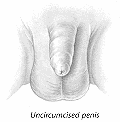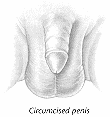|
OBSTETRICIANS AND GYNECOLOGISTS A layer [Wrong already! TWO layers] of skin, the foreskin, covers the glans (head) of the penis. Circumcision is the surgical removal of this foreskin. If it is done, it's usually done soon after birth. Whether to have your son circumcised is your decision.
Making the Decision Circumcision is an elective procedure. That means it is the parents' choice whether to have their son circumcised. [Circumcision is the only "elective" surgery not elected by the patient.] In most cases, there is no medical reason for a circumcision. It is not required by law or by hospital policy [...which will be news to some hospital staff]. Although many [2008: most, though that is less true than before] newborn boys in the United States are circumcised, it is much less common in Northern Europe and other parts of the world. [Why mention only Northern Europe? Neonatal circumcision is much less common in all other parts of the world except Israel. See a map of circumcision's worldwide distribution.] Some parents have their sons circumcised for religious or cultural reasons. Moslems and Jews, for example, have circumcised their male newborns [No, Moslems usually wait several years] for centuries [...originally using flint knives - literally, a stone-age ritual]. Some parents choose to have their sons circumcised for the sake [2008: because of] of hygiene. Smegma - a cheesy [2008: cheese-like] discharge containing dead cells [Hair and nails and the outer layer of the skin are entirely made of dead cells]- can build up under the foreskin of males [and females] who are not circumcised . This can lead to odor or infection [if grossly neglected]. A boy can be taught to wash his penis to get rid of smegma as a part of his daily bathing routine. Some parents choose not to circumcise their sons because they are worried about the pain the baby feels or the risks involved with the surgery. [And some parents choose not to have part of their son's penis cut off for a number of other excellent reasons such as its detriment to his sex life or because it's his body, not theirs.] Some doctors feel that circumcision lowers the risk of sexually
transmitted diseases (STDs).   [These images seem designed to minimise the difference between the two - especially the colour of the raw, freshly denuded glans] The Procedure Circumcision is done before the mother and baby leave the hospital. [At least that's when the obstetricians and gynaecologists - specialists in women's bodies - want it done, because then they get to do it.] During the procedure, the baby is placed on [no, strapped down to] a special table. The doctor may use local anesthesia to lessen the pain. Various surgical techniques are used, but they follow the same steps:
The procedure is done quickly. The baby will cry [no, shriek] during and for a short
while afterward. Risks
In rare cases, the circumcision may need to be redone. [Added in 2008. It is not "redone" of course, but revised, a euphemism for "repaired", if that is possible] Caring for Your Newborn Circumcised Infants
With one type of circumcision, a plastic ring is left on the penis. This ring will [usually] slip off when the edge of the circumcision is fully healed. Uncircumcised Infants
Teach your boy to wash his penis, including under the foreskin after it has begun to retract. Once he learns to do this, it will become part of his daily routine. Finally... Deciding whether to circumcise your newborn boy [or leave him the way he was born, perfect] is an important choice for parents. Remember, circumcision is elective [= unnecessary] - it is your choice whether to have it done. [But whose penis is it?] If you have any questions or concerns, talk with your doctor about them during your pregnancy so you have enough time to make an informed decision. Glossary Foreskin: A layer of skin covering the end of the penis. [No, the foreskin usually is the end of the penis. It's an integral part.] Glans: The head of the penis. Local Anesthesia: The use of drugs that prevent pain in a part of the body. Sexually Transmitted Diseases (STDs): Diseases that are spread by sexual contact, including chlamydial infection, gonorrhea, genital warts, herpes, syphilis, and infection with human immunodeficiency virus (HIV, the cause of acquired immunodeficiency syndrome [AIDS]).
[Here is a more complete glossary] Copyright March 1999 [August 2008] American College of Obstetricians and Gynecologists
[No mention of any ethical issues or human rights, no mention of any effect on sexuality, no mention of the certain loss and damage caused by circumcision. This leaflet seems closely based on that of the American Academy of Pediatrics.]
|